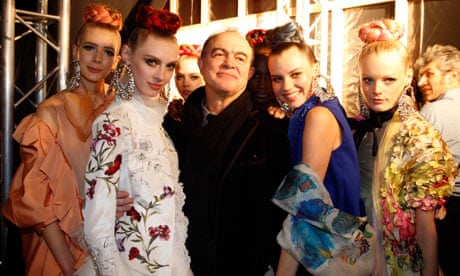Even as a child, Christian Lacroix had firm ideas about what was beautiful. Growing up in Arles in the south of France, he remembers sketching the landscape obsessively, not because he was trying to capture its qualities but rather because he thought it could be improved.
"I was bored," he says now, 50 years on. "I never loved the world around me as it was. It seemed dirty and dull, so I sketched all day long: this rock, this flower, this field, anything I saw. I re-designed it all in my own style." He gives a small smile. "Now that is my job every day."
Lacroix, 59, is sitting in a side-room in the Musée du quai Branly in Paris, where he is currently enjoying a stint as artistic director for an exhibition tracing the evolution of female traditional dress in the Middle East. "L'Orient des Femmes" is Lacroix's first foray into the Paris fashion scene since the house that bore his name went into voluntary receivership in 2009, having racked up almost €10m in losses, with further debts of €44m.
After six months in administration, the designer was forced to abandon his clothing lines as part of a restructuring plan that saw the licensing out of the Lacroix name for the sale of perfume and accessories. The 124-strong workforce was slashed to 12. Lacroix, too, was out of a job.
"I think it's always difficult to reconcile the needs of art and business," he admits, speaking in rapid, accented English. "I think this was part of the trauma for Alexander McQueen [who killed himself last year]. I tried to do both: to provide not only money for my workers but also something else, something that was beautiful, which brings out pleasure or emotion."
Ultimately, however, Lacroix failed to find the necessary equilibrium between brilliance and the balance sheet. The collapse of his empire was a humiliating fall from grace for a designer regarded by many in the fashion world as an artistic genius. In his heyday, Lacroix's flamboyant creations – such as the short puffball skirt – became embedded in popular culture, partly thanks to Jennifer Saunders's character Edina in the sitcom Absolutely Fabulous.
Still, Lacroix bats away any suggestion of lingering bitterness. "I am not nostalgic for the past," he insists. "And for me, being a museum curator was a childhood dream." In fact, many of his catwalk shows were directly inspired by historical costume and while Lacroix was a student at the Sorbonne in Paris, he gained a qualification in museum studies.
The exhibition at the Musée du quai Branly consists of a striking ensemble of 150 gowns and accessories dating from the 13th century, each painstakingly embroidered in vibrant colours by women in Syria, Palestine and Jordan. The garments, some from the museum's own archive and some on loan from a private collection, have never been seen in public before.
"There is an opulence to this work," says Lacroix. "It's the idea of these anonymous women making their dresses, very simple, very rustic, and yet you see all the richness in the detail, all the colours like a beautiful flower.
"It's about the self-expression of individuality and I think that is so different from what we are seeing in fashion nowadays, which seems to be connected more and more with status symbols and logos."
Does he believe that the fashion industry has become less interesting, less creative in recent years? "I think fashion is a little bit mixed-up. People want to be in their own fashion tribes, so they want to wear the same clothes to be connected to everyone else in that tribe. But they want to be different from other tribes.
"These clothes [in the exhibition]... are much more alive than the clones who people our streets, more inspired and inspirational than any fashion catwalk."
Lacroix was involved in each stage of putting together the exhibition – from the choice of gowns to how they are displayed and even to the design of the publicity poster. He was also able to pull in some fashion world favours: the exhibition's patron is France's first lady, former supermodel Carla Bruni-Sarkozy.
For Lacroix, who made his name as a designer during the financial boom of the 1980s when his lavishly artistic and astronomically expensive haute-couture creations seemed to embody the spirit of the times, the most striking thing about the garments on show is their unalloyed vibrancy.
"We wanted to get away from the idea that the women in this part of the world only wear black, to make themselves disappear," he explains. "For me, these gowns are about liberation. They have been the same shape for millennia but each one is also unique. That's exactly what I consider couture to be: it's a one-of-a-kind garment for one woman, for one event, for her whole life."
But, as the exhibition notes point out, the rise of Islamic fundamentalism in this part of the world has meant that these traditional, colourful robes are in danger of being superseded by the cultural dominance of the burqa.
"I can't stand it when women are forced to wear the burqa," says Lacroix. "It's something that is a negation of their own character and personality... I'm against anything that is dictated by religion, even Christianity. But that is a long story."
And in spite of his reputation for grandiosity, it is true that Lacroix has always prided himself on his capacity for appreciating the understated and the everyday. He seems remarkably stable for a fashion designer and has been with his wife, Françoise, for almost 40 years. When we meet, he is dressed for practicality rather than for show in a black overcoat, a black-and-grey striped scarf and flat, sturdy boots.
"I have always loved raw and popular art, respected anonymous pieces much more than pompous trademarks, signatures, arrogant labels and logos," he writes in the exhibition catalogue. Today, the man who once designed Christina Aguilera's wedding dress bemoans the fact there are no longer "people with money who also have culture" and insists that designers must "connect with the everyday, with real life" to stand a chance of surviving in the challenging economic climate.
"In my day, everything was possible [in fashion]," he says. By contrast, Lacroix believes that designers now have to choose between selling affordable clothes with mass appeal to ensure a profitable business model or instead focusing all their efforts on producing one-off garments for a tiny coterie of rich clients. "I think it will be interesting," he says. "The next generation will either have to appeal to a wide market, to make everything affordable with the latest technologies. On the other hand, they will choose to do haute couture but they will have fewer and fewer customers.
"It's difficult to find the balance between 'arty' clothes for a few women and something that is supposed to provide money for your workers. I know some designers who have become just a label, a name, and I know they are a bit embarrassed by that. They feel their creativity is constricted."
Lacroix's creativity, however, seems to have flourished since the demise of his fashion empire. Last February, he produced a series of costumes for the Berlin State Opera's production of Handel's Agrippina and he has worked with the New York Met, designing clothes for the soprano Renée Fleming. Lacroix has also started a collaboration with Spanish high-street clothing chain Desigual, and is launching his own furniture collection in April.
"Nowadays, my couture side is expressed on stage," he says, taking a final sip from a large bottle of Evian. He appears content with his new life but also a touch resigned to the fact that his artistry now finds its outlet in museum archives and opera productions rather than on the catwalk, in the full glare of the world's media. Although no longer affiliated with the fashion house that bears his name, it seems there is a part of Christian Lacroix that will always remain a sketching child; that will always seek to make the world around him a touch more beautiful than it already is.



Comments (…)
Sign in or create your Guardian account to join the discussion